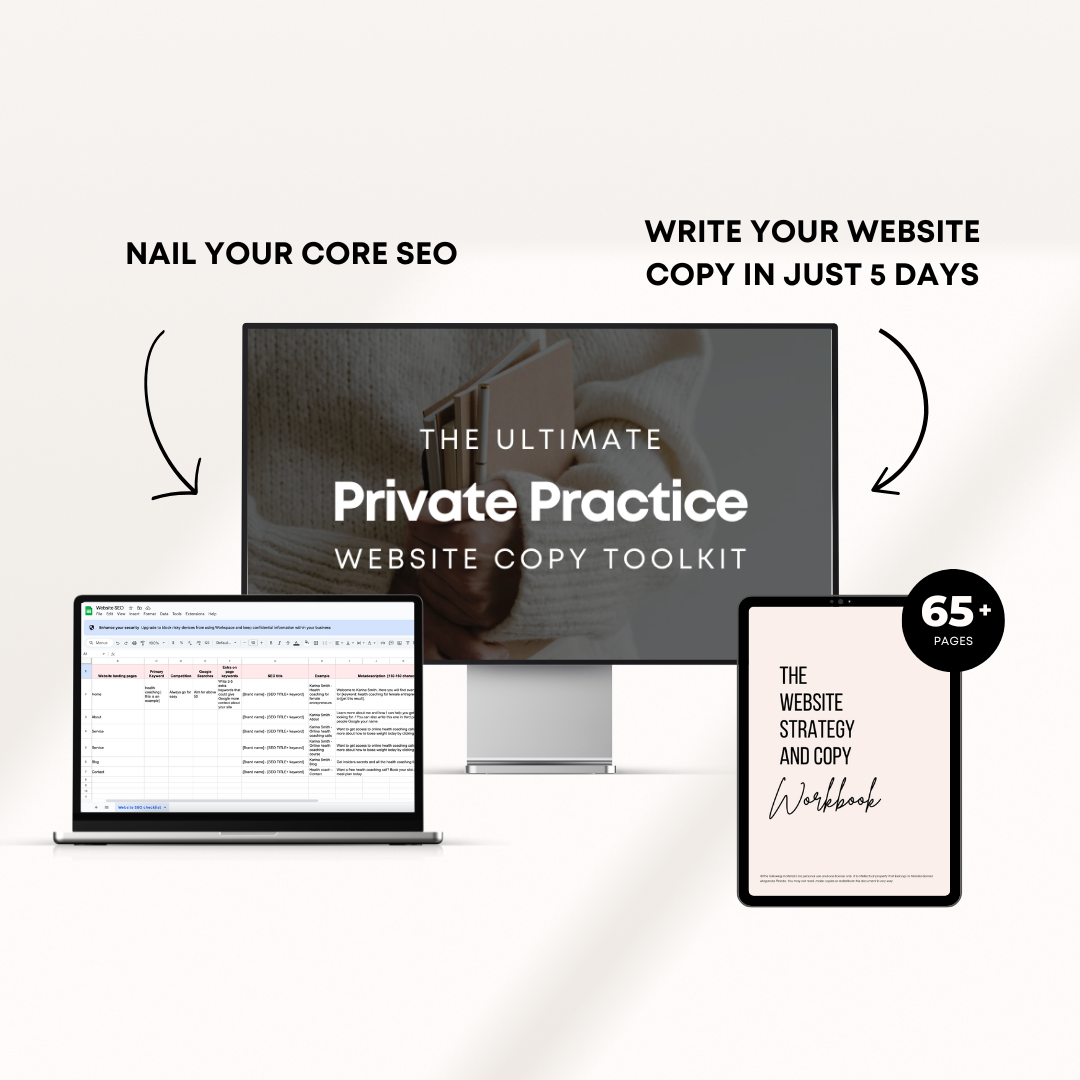The stress-free guide to becoming an entrepreneur in healthcare
The healthcare industry is evolving, and more professionals are stepping away from traditional roles to launch their own businesses. Whether you’re a therapist, doctor, or health coach, becoming an entrepreneur in healthcare allows you to take control of your career, increase your income, and make a greater impact. However, transitioning from a practitioner to a business owner can feel overwhelming.
In case you’re new here, I’m Natalia Maganda, and I help private practice owners create and manage a strategic, client-attracting website—without the tech headaches. If you want a website that works for you while you focus on your clients, you’re in the right place. Learn more about my web design services for healthcare entrepreneurs.
What is a healthcare entrepreneur?
A healthcare entrepreneur is someone who launches a business within the healthcare industry. Unlike traditional healthcare providers who work within hospitals, clinics, or corporate settings, healthcare entrepreneurs build their own private practices, telehealth services, wellness programs, or health-tech companies.
Entrepreneurship in healthcare isn’t just about starting a business—it’s about solving problems in innovative ways. Whether it’s through direct patient care, digital health solutions, or consulting, healthcare entrepreneurs have the opportunity to create profitable and sustainable businesses that serve people on their own terms.
Why is becoming a healthcare entrepreneur so challenging?
Starting a healthcare business comes with unique challenges that many other industries don’t face. Understanding these roadblocks ahead of time can help you navigate them more smoothly.
Navigating regulations and licensing
Healthcare is a highly regulated industry, and starting a business requires compliance with federal, state, and industry laws. Depending on your field, you may need specific licenses, malpractice insurance, HIPAA compliance, and professional certifications. These legal and ethical considerations can feel overwhelming, which is why many new healthcare entrepreneurs work with legal or business consultants to set up their practice correctly.
Balancing patient care with business strategy
Many healthcare professionals enter the field because they want to help people, not run a business. However, entrepreneurship requires shifting your mindset from just providing care to also growing and managing a business. Learning to balance client care with marketing, finances, and operations is essential to avoid burnout.
Overcoming financial and startup costs
Unlike other industries, starting a healthcare business can be expensive. Costs may include:
- Office space, equipment, and supplies
- Malpractice insurance and business licensing
- EHR software, scheduling tools, and telehealth platforms
- Marketing and website development
However, there are ways to minimize overhead costs by starting small, using digital tools, and outsourcing tasks strategically.
How to become an entrepreneur in healthcare
Step 1 – Identify your niche
The most successful healthcare entrepreneurs focus on a specific audience and service. Instead of trying to serve everyone, identify a profitable niche based on your skills and market demand. Some examples include:
- Private therapy practice for anxiety and trauma
- Concierge wellness coaching
- Telehealth for specialized care
- Digital courses or membership programs for patient education
Step 2 – Develop a business plan
A solid business plan is the foundation of any successful healthcare business. Outline your:
- Services and pricing structure
- Target audience and marketing strategy
- Legal and compliance requirements
- Revenue goals and budget
Step 3 – Build an online presence
In today’s digital world, your website and online presence are essential for attracting clients. A professionally designed website with SEO-optimized content will help potential clients find and trust you. Consider creating:
- A user-friendly website with clear service offerings
- An educational blog or resource hub
- An email list for client engagement
Step 4 – Streamline operations with technology
To reduce stress and avoid admin overload, leverage automated tools like:
- EHR systems for secure patient documentation
- Scheduling and billing software
- Telehealth platforms for remote consultations
- Social media automation for consistent marketing
Using technology to handle administrative tasks allows you to focus on client care without feeling overwhelmed.
Examples of successful healthcare entrepreneurship
There are many ways to become a profitable healthcare entrepreneur beyond traditional private practice. Some high-demand opportunities include:
- Private practice ownership – Therapists, chiropractors, functional medicine clinics
- Health coaching & consulting – Wellness programs, nutrition coaching
- Telehealth startups – Virtual therapy, online mental health platforms
- Medical tech & innovation – AI-driven diagnostics, health apps
- Home healthcare & senior services – Mobile nursing, concierge medicine
Choosing the right model depends on your expertise, interests, and market demand.
What is the most profitable business in healthcare?
Some of the most profitable healthcare businesses today include:
- Concierge medicine & wellness coaching – High-end, cash-pay models for personalized care
- Telehealth & online therapy – Digital health services that lower overhead costs
- Health-tech startups – Apps, AI-driven diagnostics, and software solutions
- Home-based senior care – Growing demand for in-home nursing and caregiving
Each of these businesses taps into rising healthcare trends, allowing professionals to serve more clients while scaling their income.
The entrepreneur mindset: How to succeed in healthcare business without the stress
The biggest shift healthcare entrepreneurs need to make is developing a business-focused mindset. Instead of just thinking like a provider, successful entrepreneurs:
- Embrace a growth mindset – Viewing challenges as opportunities to refine their business
- Outsource and automate tasks – Delegating admin work so they can focus on client care
- Network and collaborate – Building relationships with other professionals for referrals and business growth
Entrepreneurship can feel overwhelming at first, but by starting small, staying organized, and using strategic systems, you can create a stress-free and profitable healthcare business.
Final Thoughts on Becoming an Entrepreneur in Healthcare
Becoming a healthcare entrepreneur is an exciting opportunity to take control of your career and create a business that aligns with your passion. While the process requires planning, strategy, and mindset shifts, the rewards are well worth it.
If you want to attract more clients and build a thriving healthcare business, having a strong online presence is essential. Let’s create a private practice website that works for you.
Related reads therapist marketing:
- How to write a thoughtful therapy termination letter
- Private pay vs insurance: pros and cons for therapists
- The best accounting software for therapists
- The guide to managing your money and private practice therapy expenses
- How to calculate private practice therapy overhead costs
- How to grow your private practice therapy with zero social media presence

* AI Disclosure: This content may contain sections generated with AI with the purpose of providing you with condensed helpful and relevant content, however all personal opinions are 100% human made as well as the blog post structure, outline and key takeaways.
* Affiliate Disclosure: Some of the links on www.nataliamaganda.com may contain affiliate links meaning that I will get a commission for recommending products at no extra cost to you.

hello! i'm natalia
Latina, web design expert for mental health professionals.
I help ambitious life coaches, therapists and holistic leaders amplify their magic, gain visibility, and simplify their marketing efforts through strategic web design and content.
If you’re looking for an all-in-one system to manage your website, emails, funnels, and CRM, Go HighLevel (affiliate link) is the most powerful tool I’ve tested—and it’s built to grow with you.
On a tighter budget or just starting out? ThriveCart (affiliate link) offers a one-time payment option and easy checkout setups that still pack a punch for digital offers and automation. (Send me an email after your purchase and make sure to use my affiliate link)









